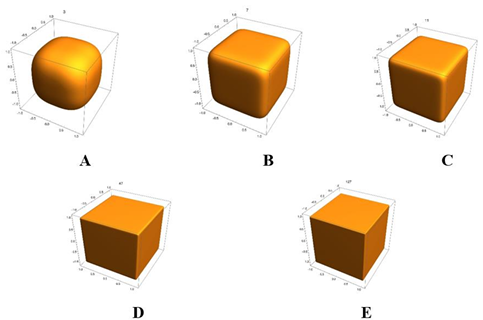


Miraculous hypercomplex numbers
Vol 1, Issue 1, 2023
Download PDF
Abstract
The development of the number system has been a long and difficult process, and many landmark concepts and theorems have been put forward. By briefly reviewing the development of hypercomplex systems, the rules for constructing the unit elements are discussed. As a vector space defining multiplication, division, and norm of vectors, hypercomplex numbers synthesize the advantages of mathematical tools such as algebra, geometry, and analysis, faithfully describe the intrinsic properties of space-time and physical systems, and provide a unified language and a powerful tool for basic theories and engineering technology. In the application of hypercomplex numbers, the group-like properties of the basis vectors are the most important, and the zero factor has little influence on the algebraic operation. The multiplication table of the basis vectors fully describes the intrinsic properties of the hypercomplex system, and the matrix A constructed from the multiplication table satisfies the structure equation A2 = nA and thus obtains a set of faithful matrix representations of the basic elements. This paper also uses typical examples to show the simple and clear concepts and wide application of hypercomplex numbers. Therefore, hypercomplex numbers are worth learning in basic education and applying in scientific research and engineering technology.
Keywords
References
- Kline M. Mathematical Thought from Ancient to Modern Times. Oxford University Press; 1972.
- Sun Z. After the plural—How far can we go (Chinese). Chinese Journal of Nature 1992; 15(8): 615–619.
- Hamilton WR. Theory of quaternions. Proceedings of the Royal Irish Academy (1836-1869) 1844; 3: 1–6.
- Frobenius H. On linear substitutions and bilinear forms (German). Journal für die Reine und Angewandte Mathematik (Crelles Journal) 1878; 1878(84): 1–63. doi: 10.1515/crelle-1878-18788403
- Hurwitz A. About the composition of the square shapes (German). Mathematische Annalen 1922; 88: 1–25. doi: 10.1007/BF01448439
- Milnor J. Some consequences of a theorem of Bott. Annals of Mathematics 1958; 68(2): 444–449. doi: 10.2307/1970255
- Gibbs JW. Elements of Vector Analysis: Arranged for the Use of Students in Physics. Tuttle, Morehouse & Taylor; 1884.
- Heaviside O. Electromagnetic induction and its propagation. The Electrician 1885; 14: 178–180.
- Grassmann HG. The Linear Expansion Theory (German). Verlag von Otto Wigand; 1844.
- Clifford WK. Applications of Grassmann’s extensive algebra. American Journal of Mathematics 1878; 1(4): 350–358. doi: 10.2307/2369379
- Clifford WK. On the classification of geometric algebras. In: Tucher R (editor). Mathematical Papers. Macmillian; 1882. pp. 397–401.
- Peirce B. Linear associative algebra. American Journal of Mathematics 1881; 4(1): 97–229. doi: 10.2307/2369153
- Study E. About systems of complex numbers (German). In: News from the Royal Society of Sciences and the Georg August University of Göttingen (German). Dieterich’sche Verlagsbuchhandlung; 1889. pp. 237–268.
- Study E. The Geometry of Dynamism (German). Druck und Verlag von B. G. Teubner; 1903.
- Kantor IL, Solodovnikov AS. In: Shenitzer A (translator). Hypercomplex Numbers: An Elementary Introduction to Algebras, 1st ed. Springer New York; 1989.
- Cayley Esq A. On the theory of groups, as depending on the symbolic equation n = 1. The London, Edinburgh, and Dublin Philosophical Magazine and Journal of Science 1854; 7(42): 40–47. doi: 10.1080/14786445408647421
- Molien T. About systems of higher complex numbers (German). Mathematische Annalen 1892; 41: 83–156. doi: 10.1007/BF01443450
- Molien T. A note on the theory of homogeneous substitution groups (German). Sitzungsberichte der Naturforscher-Gesellschaft Dorpat 1897; 11: 259–274.
- Frobenius G. On the Representation of Finite Groups by Linear Transformations (German). Preussischen Akademie; 1897.
- Cartan E. Bilinear groups and complex number systems (French). Annales de la Facultė des Sciences de Toulouse: Mathėmatiques 1898; 12(1): B1–B64.
- van der Waerden BL. Chapter 10, 11, 13. In: A History of Algebra: From al-Khwārizmī to Emmy Noether, 1st ed. Springer Berlin; 1985. doi: 10.1007/978-3-642-51599-6
- Wedderburn JM. On hypercomplex numbers. Proceedings of the London Mathematical Society 1908; 2(1): 77–118.
- Dickson LE. On hypercomplex number systems. Transactions of the American Mathematical Society 1905; 6(3): 344–348.
- Dickson LE. On quaternions and their generalization and the history of the eight square theorem. Annals of Mathematics 1919; 20(3): 155–171. doi: 10.2307/1967865
- Gu Y. Hypercomplex numbers and roots of algebraic equation. Journal of Geometry and Symmetry in Physics 2022; 64: 9–22. doi: 10.7546/jgsp-64-2022-9-22
- Gu Y. Clifford algebras, hypercomplex numbers and nonlinear equations in physics. Geometry, Integrability and Quantization 2023; 25: 47–72. doi: 10.7546/giq-25-2023-47-72
- Calvet RG. On matrix representations of geometric (Clifford) algebras. Journal of Geometry and Symmetry in Physics 2017; 43: 1–36. doi: 10.7546/jgsp-43-2017-1-36
- Gu Y. A note on the representation of Clifford algebras. Journal of Geometry and Symmetry in Physics 2021; 62: 29–52. doi: 10.7546/jgsp-62-2021-29-52
- Gu Y. Clifford algebra and hypercomplex number as well as their applications in physics. Journal of Applied Mathematics and Physics 2022; 10(4): 1375–1393. doi: 10.4236/jamp.2022.104097
- Hawkins T. Hypercomplex numbers, lie groups, and the creation of group representation theory. Archive for History of Exact Sciences 1972; 8: 243–287. doi: 10.1007/BF00328434
- Lounesto P. Clifford Algebras and Spinors, 2nd ed. Cambridge University Press; 2001. pp. 25–37.
- Hestenes D. Spacetime physics with geometric algebra. American Journal of Physics 2003; 71(7): 691–714. doi: 10.1119/1.1571836
- Doran C, Lasenby A. Geometric Algebra for Physicists. Cambridge University Press; 2003.
- Ablamowicz R, Baylis WE, Branson T, et al. In: Ablamowicz R, Sobczyk G (editors). Lectures on Clifford (Geometric) Algebras and Applications. Birkhäuser; 2004.
- Ablmowicz R. Clifford Algebras: Applications to Mathematics, Physics, and Engineering. Birkhäuser; 2004.
- Lundholm D, Svensson L. Clifford algebra, geometric algebra, and applications. Available online: https://www.mathematik.uni-muenchen.de/~lundholm/clifford.pdf (accessed on 21 September 2023).
- Perwass C, Edelsbrunner H, Kobbelt L, Polthier K. Geometric Algebra with Applications in Engineering. Springer Berlin; 2009. doi: 10.1007/978-3-540-89068-3
- Dressel J, Bliokh KY, Nori F. Spacetime algebra as a powerful tool for electromagnetism. Physics Reports 2015; 589: 1–71. doi: 10.1016/j.physrep.2015.06.001
- Gu Y. Clifford Algebra and Unified Field Theory. LAP LAMBERT Academic Publishing; 2020.
- Gu Y. Hypercomplex numbers and the origin of celestial magnetic fields. In: Proceedings of the ATINER’s Conference; 13 September 2023; Athens, Greece.
- Gu Y. Spinor equation and operator algebra. Journal of Geometry and Symmetry in Physics 2023; 66: 1–34.
- Ell TA. Hypercomplex Spectral Transformations [PhD thesis]. Minnesota University; 1992.
- Sangwine SJ. Fourier transforms of colour images using quaternion or hypercomplex, numbers. Electronics Letters 1996; 32(21): 1979–1980. doi: 10.1049/el:19961331
- Lan X, Liu W. Fully quaternion-valued adaptive beamforming based on crossed-dipole arrays. Electronics 2017; 6(2): 34. doi: 10.3390/electronics6020034
- Took CC, Xia Y. Multichannel quaternion least mean square algorithm. In: Proceedings of the 2019 IEEE International Conference on Acoustics, Speech and Signal Processing (ICASSP); 12–17 May 2019; Brighton, UK. pp. 8524–8527.
- Xiang M, Enshaeifar S, Stott AE, et al. Simultaneous diagonalisation of the covariance and complementary covariance matrices in quaternion widely linear signal processing. Signal Processing 2018; 148: 193–204. doi: 10.1016/j.sigpro.2018.02.018
- Liu Y, Zhang D, Lou J, et al. Stability analysis of quaternion-valued neural networks: Decomposition and direct approaches. IEEE Transactions on Neural Networks & Learning Systems 2018; 29(9): 4201–4211. doi: 10.1109/TNNLS.2017.2755697
- Parcollet T, Morchid M, Linares G, Mori RD. Bidirectional quaternion long short-term memory recurrent neural networks for speech recognition. In: Proceedings of the 2019 IEEE International Conference on Acoustics, Speech and Signal Processing (ICASSP); 12–17 May 2019; Brighton, UK. pp. 8519–8523.
- Valle ME, Lobo RA. Hypercomplex-valued recurrent correlation neural networks. Neurocomputing 2021; 432(7): 111–123. doi: 10.1016/j.neucom.2020.12.034
- Nadler A, Bar-Itzhack IY, Weiss H. On the algorithms for attitude estimation using GPS. In: Proceeding of the 39th IEEE Conference on Decision and Control; 12–15 December 2015; Sydney, Australia. pp. 3321–3326.
- Tayebi A, Mcgilvray S. Attitude stabilization of a VTOL quadrotor aircraft. IEEE Transactions on Control System Technology 2006; 14(3): 562–571. doi: 10.1109/TCST.2006.872519
Supporting Agencies
Copyright (c) 2023 Yingqiu Gu
License URL: https://creativecommons.org/licenses/by/4.0
Editor-in-Chief

Prof. Youssri Hassan Youssri
Cairo University, Egypt
Asia Pacific Academy of Science Pte. Ltd. (APACSCI) specializes in international journal publishing. APACSCI adopts the open access publishing model and provides an important communication bridge for academic groups whose interest fields include engineering, technology, medicine, computer, mathematics, agriculture and forestry, and environment.


.jpg)

.jpg)
